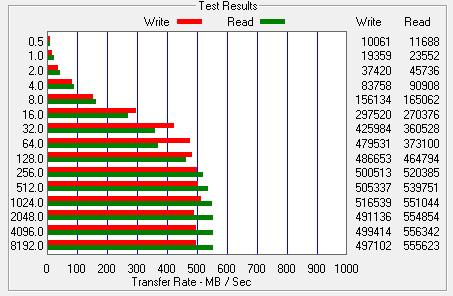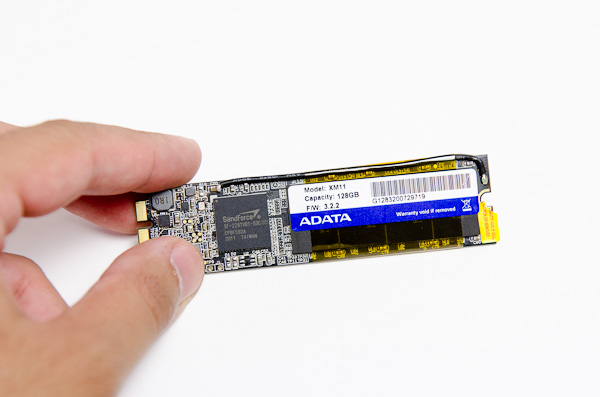ASUS Zenbook (UX21) Review
by Anand Lal Shimpi on October 22, 2011 8:00 PM ESTTwo SSD Options: SandForce and SanDisk
Like many OEMs, ASUS sources SSDs from two vendors for its Zenbook line: ADATA and SanDisk. Unlike Apple however, the division isn't random. ADATA supplies all 128GB drives while SanDisk handles the 256GB drives. The explanation is simple: ASUS needed a drive that could fit all of its NAND on a single side. SanDisk had a 256GB offering that met those needs; ADATA/SandForce did not.
ASUS didn't specify what SanDisk controller was in use on the 256GB drives, but I suspect it's the U100. ASUS supplied the following test data comparing the two SSDs:

Performance is actually comparable between the two, which is surprising. I'm going to see about getting my hands on a 256GB SanDisk model for comparison to verify for myself. The sample laptop we received comes with the 128GB ADATA drive, which performed quite well in our tests:

Granted you're looking at highly compressible datasets, but being able to break 500MB/s puts this drive up there with the standard desktop SF-2281 offerings.
If you caught our Zenbook teardown you may have noticed a firmware label on the ADATA drive indicating it was using SandForce firmware revision 3.2.2. Uhoh! SandForce just recently announced that there is a known bug in all version of the SF-2281 firmware prior to 3.3.2 that can cause BSODs. I asked ASUS when we'd see an updated firmware and why on earth it chose to ship a drive with a widely known bug.
During development, ASUS tested 100+ Zenbooks with 100+ samples of the ADATA drive. The testing included over 50,000 accumulated reliability tests including rapid sleep/wake cycles, 3DMark and other application based tests. In addition to pre-production testing, ASUS conducted additional testing on mass production units. Throughout this entire process ASUS didn't see any reliability issues with the SandForce drives and thus felt comfortable shipping with them. I should add that we have seen many cases where the SF BSOD bug simply won't appear on certain platforms, lending credibility to ASUS' claims that the SandForce drives proved stable during testing.
That being said, I'd still feel more comfortable with an upgrade to 3.3.2 if it turns out that this firmware revision does in fact fix a known issue with the drive.
I pointed out the obvious rework on the ADATA SSD to ASUS engineering. The team responded by saying the rework was implemented to reduce EMI, which was a bit too close to the margins before the change. The rework has since been incorporated into a surface mount component design which will ship in a future spin of the drive. I'm not a huge fan of reworks on shipping products but from time to time they do appear. The nature of the rework and quality of the workmanship are also important to keep in mind, both of which are less alarming in this case than others.











109 Comments
View All Comments
Panlion - Sunday, October 23, 2011 - link
Good call. I could not install windows using the USB 3 drive so having an USB 2 port saved me.I also think by having the power, USB3, and the 2 mini VGA and HDMI port on the same side, you have a real possibility of having a docking station like block for this notebook.
ggathagan - Monday, October 24, 2011 - link
Given that Asus does not sell this computer without an installed OS, I doubt that concern is even on their radar.DanNeely - Monday, October 24, 2011 - link
Unless you think that they've never considered how to do a restore after an SSD failure your assumption can't be true.komoornik - Sunday, October 23, 2011 - link
What about the heat and noise? No detailed tests?tipoo - Sunday, October 23, 2011 - link
Yeah, I recall Asus making some claims about this cooling system vs the "Fruit Brand" (yes they really said that) cooling system.lukarak - Sunday, October 23, 2011 - link
Then again, the first MBA was also not impressive, but that was some years ago. This is too little, too late imo.The price is competitive, but the thing is, the smaller you go with laptops, the price and what you get for it becomes less important, and the general feeling of usage starts to play a bigger role.
I know it's not easy to make a trackpad that will be as integrated into the OS like the MBxs. It's good that some gestures are making its way to other systems.
But for me, the biggest one, especially on such small screens, is the ability to swipe between multiple desktops available in OS X. That makes me work so much faster. I sometimes have 10 desktops open, and getting to them without having to use key combinations is just something i couldn't live without anymore. Even if it means paying 100 or 200 more for the same performance.
popej - Sunday, October 23, 2011 - link
I haven't noticed any info about screen type, but looking at the pictures it works like a mirror. IMHO you can't call notebook truly portable if it has glare screen. Reflections severely limit range of places, where it can be used comfortably.yzkbug - Sunday, October 23, 2011 - link
Ditto!JohnMD1022 - Sunday, October 23, 2011 - link
"ASUS elected to use torx bits instead of standard phillips heads to better match the industrial design of the system. While I appreciate the attention to detail I think I'd be happier if ASUS had stuck to standard screws."Most people, including computer geeks, don't have torx drivers around the house, as they do regular and Phillips screwdrivers.
However, a quick trip to Sears and about $5 will fix you up with the needed size.
lukarak - Sunday, October 23, 2011 - link
To be honest, that could be true 10 years ago, but now, torx (and torx security) is pretty much a standard.Now the new 'players' are tri-wing (although they started to appear in some boxed sets) and apple's pentalobe.